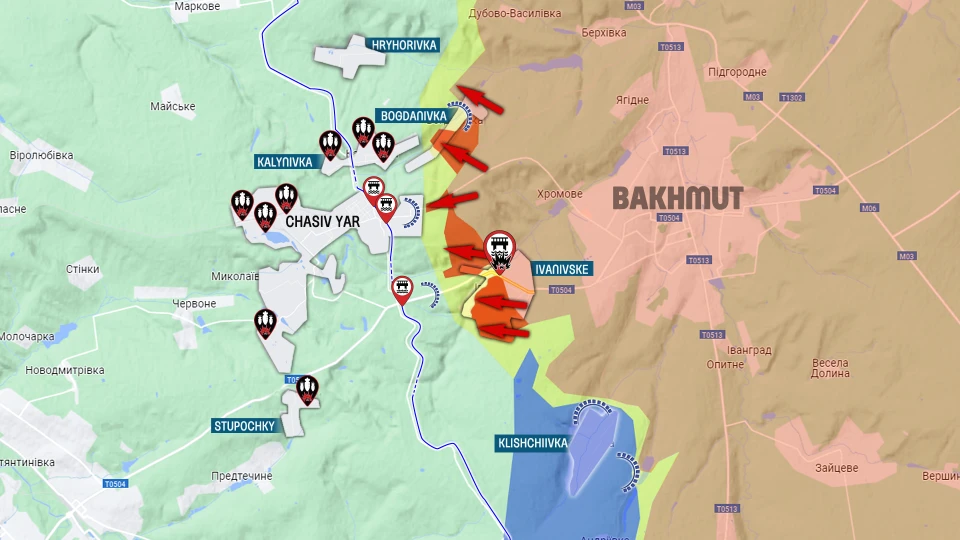
Ukraine's dependence on US assistance. Technological solutions and frontline update. Serhiy Zgurets's column
Russia exploits a window of opportunity due to delays in US military aid to Ukraine. Ukrainian Defense Forces sparingly employ artillery and air defense systems
Military aid to Ukraine
On April 17, US Defense Secretary Lloyd Austin and Chairman of the Joint Chiefs of Staff Charles Brown urged Congress to swiftly approve legislation for aid to Ukraine. Brown noted Ukraine faces dire battlefield conditions with its military under Russians pressure.
The vote on the bill for US aid to Ukraine is set for April 20th in Congress, allocating UAH 61 billion to Kyiv. A third of the funds are earmarked for replenishing American arsenals. In reality, passing this bill unlocks the supply of equipment and arms, including ATACMS. The US has sufficient reserves of this weaponry. The likelihood of this positive decision being adopted for Ukraine this time is quite high.
European assistance to Ukraine is also increasing, notably through the Czech initiative, which involves supplying Ukraine with a significant amount of ammunition, though these supplies have not yet arrived. Ukraine's arsenal of new air defense missile systems is also growing. Germany has announced the supply of another Patriot system to Ukraine. The German company Diehl Defence, which manufactures the IRIS-T air defense missile system in various versions, has reported delivering three batteries to Ukraine, with more to come this year. Another battery will be delivered in a few weeks. Russia fears this new wave of reinforcement, hence its full-scale deployment to seize more territory.
Battlefield situation
The situation on the front line remains extremely challenging. The Russian forces maintain superiority in armament and manpower, attempting to break through the Ukrainian Armed Forces' defensive lines. Russians seek to expand conflict zones, as new areas of active engagement emerge, notably in Novokalynove. Russia conducts information-psychological operations, fueling discussions about the preparation for a large-scale offensive on Kharkiv to influence Ukrainian society's resilience. This is coupled with regular missile and bomb attacks on Kharkiv, Sumy, Chernihiv, and other areas and cities near the border with the aggressor state.
Over the last day, 68 clashes took place, most of them in the Novopavlivka direction. The most strategically important area remains the Bakhmut direction and the situation around Chasiv Yar.
Chasiv Yar
Yuriy Fedorenko, commander of the AHILLES Air Assault Battalion of the 92nd Separate Assault Brigade named after Ivan Sirko, told what tactics the Russian troops are using at the front, including around Chasiv Yar.

According to him, over the past few days, despite constant assault operations, the Russian forces have not had any tactical successes on the battlefield. The Russian military continues to assault in the direction of the main concentration of efforts, i.e. Chasiv Yar itself. The Russian forces are also trying to outflank the area, moving to Ivanivske and Bohdanivka. Active fighting continues. Near Ivanivske and Bohdanivka, a fierce struggle for every house and street is going on. A number of positions are changing hands. Nevertheless, the Ukrainian Defense Forces manage to hold the line quite actively.
"The enemy employs various tactics. In some places, they attempt to accumulate personnel on foot. The Russians move with a distance interval, approximately 15-20 meters per person during daylight hours. They advance to forward positions and gather there. Later, during periods of the day when it is not yet dark but no longer light, or vice versa when dawn breaks, they mostly engage in active assault actions. The occupiers' goal is to dislodge our units from their forward positions," Fedorenko explained.
Another tactic is when Russia employs a significant amount of lightly armored vehicles. The Russians try to do this swiftly and maneuverably, bringing their personnel to the front line.
"Today, the enemy came out with three units of IFVs. One unit was destroyed, burned down by our unit on the move. Another one was also burned down by military anti-tankers. The third unit was able to leave the battlefield because it did not reach the most possible sector of destruction for us. Other groups were also eliminated later. That is why active defense is quite intense now," said the commander of the AHILLES Air Assault Battalion.
Much depends on the quantity of technical assets, including reconnaissance and strike UAVs, electronic warfare means, says Fedorenko. That's why it's critically important and necessary now. It's what saves lives and enables the Ukrainian Armed Forces to maintain a steady dynamic on the front line. Currently, Ukrainian military indeed face certain challenges with the quantity of ammunition for other firepower systems, including cannons, rocket artillery, and air defense.
"The enemy has also adopted the tactic it used in the Avdiivka direction. They are trying to implement it in the Bahmut direction as well, particularly using a significant amount of aviation with guided bombs, attempting to destroy the positions of the Ukrainian Defense Forces and leaving only scorched earth behind. There are a lot of guided bombs flying into the city of Chasiv Yar at the moment. However, the enemy has not been able to achieve the same intensity as in Avdiivka. This is due to more favorable air defense positions. But now it's one of the key problems. Therefore, the military eagerly await additional air defense means, ammunition for them, and also F-16 aircraft, which would help solve this issue," said Fedorenko.
Currently, Russian occupying forces' generals, despite personnel and equipment losses, are attempting to implement Putin's plan regarding May 9th, says the serviceman. However, he believes that Russia will not be able to fully realize these intentions.
Ukrainian Armed Forces' expenditure rates and damage to the Russian army
At the moment, the unit is using over 50 FPV drones per day, sometimes up to 80. The cost of 50 drones is UAH 1 million. Approximately 25 targets can be hit and destroyed, Fedorenko reported. This represents a significant firepower impact on Russian positions and infantry units. The destroyed Russian armored vehicles are the result of a systematic supply to the units, including through donations, of the necessary equipment, both reconnaissance and strike FPV drones. The serviceman also noted the important role played by night bombers.
New technology solutions
Fedorenko noted that in warfare, reconnaissance information stands as one of the key elements. Accordingly, the Ukrainian Armed Forces manage to understand and identify the enemy quite clearly: their numbers, take-off locations, composition, how they carry out combat tasks, and what equipment the unit uses.
"If we understand where the enemy is located, we can always conduct reconnaissance on them. This requires a large quantity of reconnaissance tools. If we already see the enemy, we can effectively destroy them using strike assets. Units are actively engaged in this. We have made significant achievements. Since the beginning of April 2024, we have managed to destroy five enemy FPV groups," reported Fedorenko.
Recruitment to the Ukrainian Armed Forces
The AHILLES battalion of the 92nd Separate Assault Brigade named after Ivan Sirko focuses primarily on mobilized soldiers and volunteers who come from civilian life. The battalion commander spoke about the algorithm and the way mobilized people are accepted into the team.
"First, there's mobilization, then a month of general military training, followed by a specialized month of training, totaling two months. Afterwards, the military member joins the unit, familiarizing themselves with the unit's operations. Next, they undergo training as part of an experienced combat crew, which takes approximately an additional month. So, within three months, a civilian becomes a fully trained soldier, capable of carrying out combat tasks to the maximum extent. That's why our numbers have increased by almost half. There are many applications, and continuous systematic work is ongoing," Fedorenko explained.
Unmanned Systems Forces
Unmanned systems are divided into everything that operates in the air - reconnaissance-strike, robotic equipment, tracked, wheeled, which operates on the ground, as well as surface and underwater drones, said Fedorenko. According to him, Ukraine is currently in absolute leadership, priority, and superiority over the entire world community and the military-industrial complex in terms of surface and underwater drones. There are no equivalents to our means in the world at the moment. Ukraine has destroyed over 25% of the Russian Black Sea fleet without having its own. Robotic equipment is also developing rapidly, performing basic tasks. This includes delivering necessary cargo to the front line of combat without risking personnel; this is done by robots. They evacuate the wounded, conduct mine clearance, and demine. Additional modules are also installed on them. In hard-to-reach areas where there is an extremely significant threat to infantry, the machine can perform tasks and engage the enemy.
Fedorenko stated that everything operating in the air conducts reconnaissance and strikes during both day and night. To effectively manage this machinery, a unified command center is necessary. Accordingly, a new type of unmanned systems troops has been formed. It is tasked with developing a concept that already exists, taken directly from battlefield applications. The focus is on configuring the management system, training, provision, and combined, effective use directly on the battlefield. These tasks cannot be accomplished quickly; it is impossible. Each step must be carefully considered. However, systematic work is being carried out in this direction. According to Fedorenko, significant progress in unmanned systems management is expected within approximately six months.
- News












































